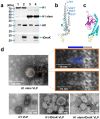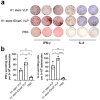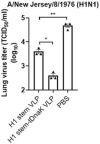Chimeric Virus-like Particles Co-Displaying Hemagglutinin Stem and the C-Terminal Fragment of DnaK Confer Heterologous Influenza Protection in Mice
- PMID: 36298664
- PMCID: PMC9610613
- DOI: 10.3390/v14102109
Chimeric Virus-like Particles Co-Displaying Hemagglutinin Stem and the C-Terminal Fragment of DnaK Confer Heterologous Influenza Protection in Mice
Abstract
Influenza virus hemagglutinin (HA) stem is currently regarded as an extremely promising immunogen for designing universal influenza vaccines. The appropriate antigen-presenting vaccine vector would be conducive to increasing the immunogenicity of the HA stem antigen. In this study, we generated chimeric virus-like particles (cVLPs) co-displaying the truncated C-terminal of DnaK from Escherichia coli and H1 stem or full-length H1 antigen using the baculovirus expression system. Transmission electronic micrography revealed the expression and presentation of H1 stem antigens on the surface of VLPs. Vaccinations of mice with the H1 stem cVLPs induced H1-specific immune responses and provided heterologous immune protection in vivo, which was more effective than vaccinations with VLPs displaying H1 stem alone in protecting mice against weight loss as well as increasing survival rates after lethal influenza viral challenge. The results indicate that the incorporation of the truncated C-terminal of DnaK as an adjuvant protein into the cVLPs significantly enhances the H1-specific immunity and immune protection. We have explicitly identified the VLP platform as an effective way of expressing HA stem antigen and revealed that chimeric VLP is an vaccine vector for developing HA stem-based universal influenza vaccines.
Keywords: DnaK; hemagglutinin stem; influenza virus; universal vaccine; virus-like particle.
Conflict of interest statement
The authors declare no conflict of interest.
Figures







Similar articles
-
Vaccination with Vesicular Stomatitis Virus-Vectored Chimeric Hemagglutinins Protects Mice against Divergent Influenza Virus Challenge Strains.J Virol. 2015 Dec 16;90(5):2544-50. doi: 10.1128/JVI.02598-15. J Virol. 2015. PMID: 26676789 Free PMC article.
-
A single-shot adenoviral vaccine provides hemagglutinin stalk-mediated protection against heterosubtypic influenza challenge in mice.Mol Ther. 2022 May 4;30(5):2024-2047. doi: 10.1016/j.ymthe.2022.01.011. Epub 2022 Jan 7. Mol Ther. 2022. PMID: 34999208 Free PMC article.
-
Immunogenicity and efficacy of replication-competent recombinant influenza virus carrying multimeric M2 extracellular domains in a chimeric hemagglutinin conjugate.Antiviral Res. 2017 Dec;148:43-52. doi: 10.1016/j.antiviral.2017.10.018. Epub 2017 Oct 26. Antiviral Res. 2017. PMID: 29107058 Free PMC article.
-
Molecular responses of agroinfiltrated Nicotiana benthamiana leaves expressing suppressor of silencing P19 and influenza virus-like particles.Plant Biotechnol J. 2024 May;22(5):1078-1100. doi: 10.1111/pbi.14247. Epub 2023 Dec 2. Plant Biotechnol J. 2024. PMID: 38041470 Free PMC article. Review.
-
DNA and protein-generated chimeric molecules for delivery of influenza viral epitopes in mouse and humanized NSG transfer models.Hum Vaccin Immunother. 2024 Dec 31;20(1):2292381. doi: 10.1080/21645515.2023.2292381. Epub 2024 Jan 9. Hum Vaccin Immunother. 2024. PMID: 38193304 Free PMC article. Review.
Cited by
-
Challenges and Opportunities in the Process Development of Chimeric Vaccines.Vaccines (Basel). 2023 Dec 8;11(12):1828. doi: 10.3390/vaccines11121828. Vaccines (Basel). 2023. PMID: 38140232 Free PMC article. Review.
-
Prokaryote- and Eukaryote-Based Expression Systems: Advances in Post-Pandemic Viral Antigen Production for Vaccines.Int J Mol Sci. 2024 Nov 7;25(22):11979. doi: 10.3390/ijms252211979. Int J Mol Sci. 2024. PMID: 39596049 Free PMC article. Review.
References
Publication types
MeSH terms
Substances
LinkOut - more resources
Full Text Sources
Medical

